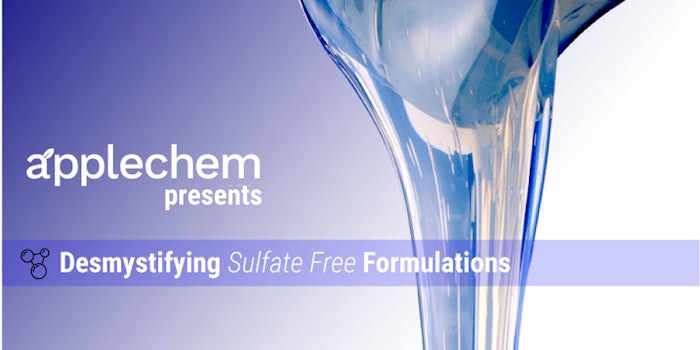
The beauty industry is ever-changing, and as the world turns away from SLS (sodium lauryl sulfate) and SLES (sodium laureth sulfate), there are new challenges that need to be addressed. As more people turn to SLS-free products, brands are scrambling to find an alternative ingredient that can thicken formulas without sacrificing clarity.
We hope that the following Q&A will help address some common questions when developing these types of sulfate-free cleansers:
What's a surfactant?
A surfactant is a chemical that helps lower the surface tension between water and the oils in your hair, which allows dirt to be rinsed off more easily.
When the head of the surfactant molecule is hydrophilic (water-loving) and the tail is hydrophobic (water-oil-loving), then when it gets mixed in water, it will form small little balls called micelles.
If you mix oil, water, and surfactant together, the oil will reside inside these micelles making it easier to wash away with water.
Are all sulfate-free surfactants easy to thicken?
Certain sulfate-free surfactants are easier to thicken than others. For example, Alpha Olefin Sulfonate is one of the more economical sulfate-free surfactants and is relatively easy to thicken.
On the other hand, glutamate-based surfactants (that is, derived from amino acids) are known for mildness and pleasing sensory, but are exceedingly difficult to thicken in a stable formula.
What happens when you mix different surfactants together?
In chemistry terms, when you mix primary surfactants with co-surfactants, you are changing the average surfactant head area, which in turn influences how the micelles are structured. This is how formulators adjust product performance.
Additionally, mixing different types of sulfate-free surfactants can result in enhanced cleansing, foaming, and sensory properties, but become that much more difficult to thicken as well.
So how do formulators thicken these types of formulations?
They do this by – you guessed it - changing the shape of the micelles! There are three classical ways to do this.
First, you can change the shape from being spherical to being longer and thinner using a co-surfactant like cocamidpropyl betaine.
Second, you can change it by adding more salt and potentially combine that with co-surfactants.
And third, you can add more hydrophobic non-ionic surfactants thickeners like glyceryl laurate or laureth-2.
These steps will all help to make that micelle shape less round and curved, thereby making the formulation easier to thicken. However these approaches are generally more effective for sulfated surfactants. For sulfate-free cleansing products, the classical methods are often not sufficient to achieve desired viscosity or clarity.
This is where a different class of ingredients known as non-ionic associative thickeners – such as our Sorbithix L-100 – begins to play an important role in thickening. And unlike other thickeners, Sorbithix has a unique star polymer shape designed to connect with surfactant heads and tails, making it easy to form a large, linked network of micelles that boosts viscosity and stability.
If you're new or unfamiliar with this type of formulation, we hope these tips will help guide your path for success! Feel free to reach out to us if you have additional questions, and you can always find more information about Applechem products at www.applechem.com
Disclaimer:
The above paid-for content was produced by and posted on behalf of the Sponsor. Content provided is generated solely by the Sponsor or its affiliates, and it is the Sponsor’s responsibility for the accuracy, completeness and validity of all information included. Global Cosmetic Industry takes steps to ensure that you will not confuse sponsored content with content produced by Global Cosmetic Industry and governed by its editorial policy.










